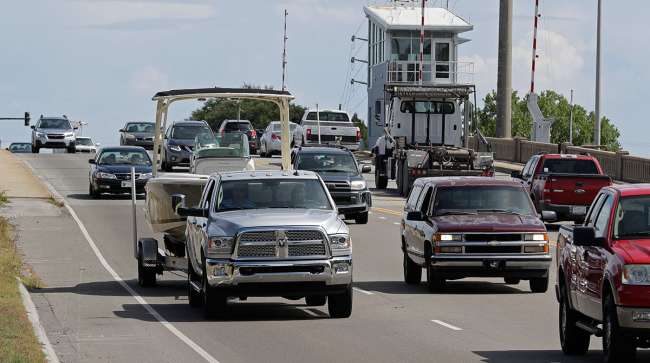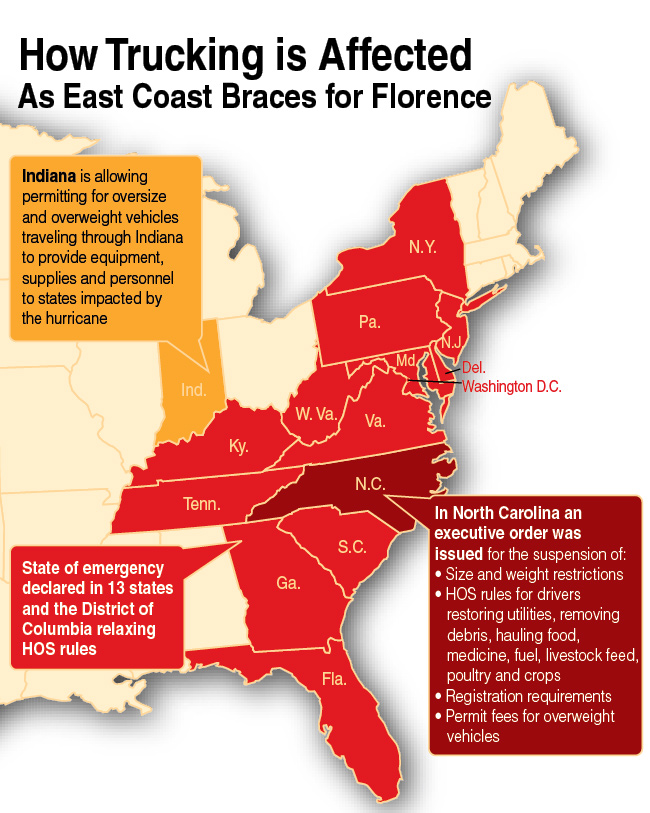Staff Reporter
HOS Rules Eased as Hurricane Florence Approaches

The Federal Motor Carrier Safety Administration has relaxed hours-of-service regulations in 13 states and the District of Columbia as Hurricane Florence makes its way to the East Coast.
The administrators at FMCSA’s Southern and Eastern Service Centers declared a state of emergency in Delaware, the District of Columbia, Florida, Georgia, Kentucky, Maryland, New Jersey, New York, North Carolina, Pennsylvania, South Carolina, Tennessee, Virginia and West Virginia by Sept. 11.

Debra Devine/Transport Topics
Hurricane Florence’s projected path is taking aim at the Carolinas with 130 mph winds and potentially ruinous rains. The Category 4 hurricane is expected to hit on Sept. 13.
“This emergency declaration is needed to address anticipated emergency conditions in the affected states and jurisdictions, creating a need for immediate transportation of supplies, equipment and persons, and provides necessary relief,” FMCSA’s notice states.
The regulatory relief applies to drivers involved directly in emergency relief efforts, such as transporting supplies, fuel and people.
FMCSA issues Regional Emergency Declaration for Hurricane Florence for the following states and the District of Columbia: Delaware, Florida, Georgia, Maryland, New Jersey, New York, North Carolina, Pennsylvania, South Carolina, Virginia, and West Virginia: https://t.co/qaYBqm2HGu pic.twitter.com/vmTbV0nghC — FMCSA (@FMCSA) September 11, 2018
According to FMCSA’s notice declaring the state of emergency, “direct assistance” terminates when a driver engages in interstate commerce to transport cargo that doesn’t relate to emergency relief efforts or when a dispatcher sends a driver to another location to begin engaging in interstate commerce.
FMCSA’s notice grants exemption from Parts 390-399 of the Federal Motor Carrier Safety Regulations, which covers parts and accessories needed for safe operation, hours of service and longer combination vehicles. Drivers are not exempt from requirements relating to commercial driver licenses, drugs and alcohol, hazardous materials, size and weight, and registration requirements.
FMCSA’s declaration will remain in effect for the duration of the emergency or until Oct. 10, whichever comes soonest.
The notice of regulatory relief came three days after North Carolina Gov. Roy Cooper issued an executive order suspending size and weight restrictions and HOS rules for drivers restoring utilities, removing debris and hauling food, medicine, fuel, livestock feed, poultry and crops.
RELATED: North Carolina governor suspends HOS, weight rules ahead of Hurricane Florence
Kentucky also issued an emergency declaration waiving certain motor carrier regulations. Kentucky Transportation Cabinet Secretary Greg Thomas on Sept. 11 suspended HOS limits, registration requirements and permit fees for overweight vehicles for drivers delivering goods, restoring utilities and removing debris.
FMCSA has previously issued similar emergency declarations in response to Subtropical Storm Alberto and Hurricane Harvey.
The American Logistics Aid Network, an organization that links logistics experts to nonprofit groups that specialize in disaster relief, activated a hurricane “micro-site” Sept. 11 that will allow groups to monitor the storm’s path and update one another on supply chain conditions in affected areas.
ALAN Executive Director Kathy Fulton explained that most requests for assistance can take a long time to surface because it is often days or weeks before government agencies assess impacts and needed services after a storm hits.
“Logistics challenges and costs are among the largest hurdles that most relief organizations face after a disaster,” Fulton said. “While we certainly hope that none of these storms will be as destructive as predicted, we’re glad to be part of an industry that can provide so many meaningful solutions — and grateful to the many companies that are already making it possible for us to help.”

